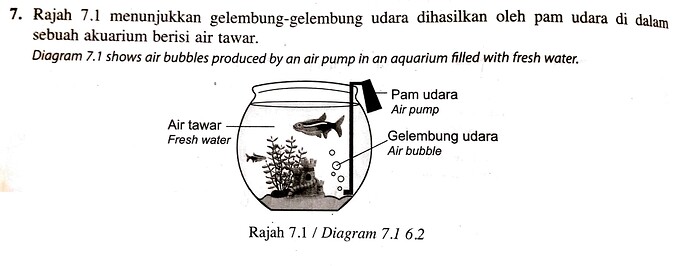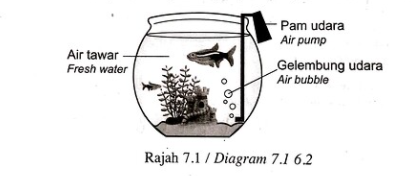- Rajah 7.1 menunjukkan gelembung-gelembung udara dihasilkan oleh pam udara di dalam sebuah akuarium berisi air tawar.
Diagram 7.1 shows air bubbles produced by an air pump in an aquarium filled with fresh water.
(c) Satu gelembung udara yang mempunyai isi padu 5 \mathrm{~cm}^{3} dibebaskan oleh pam udara pada kedalaman 0.5 \mathrm{~m} . Hitung isi padu gelembung udara itu apabila sampai di permukaan air. [Anggapkan tekanan atmosfera adalah 10 \mathrm{~m} air]
An air pump releases an air bubble with a volume of 5 \mathrm{~cm}^{3} at a depth of 0.5 \mathrm{~m}. Calculate the volume of the air bubble when it reaches the surface of the water. [Assume that the atmospheric pressure is 10 \mathrm{~m} water ]
[2 markah / 2 marks]
First step: Calculate pressure at depth of 0.5 m
At a depth of 0.5 m, the total pressure acting on the bubble is:
P = 10 m water + 0.5 m water = 10.5 m water
The conversion of pressure in m water to Pa is as follows, based on water density of 1000 kg/m³
P = ρhg = 1000(10.5)(9.81) = 103,005 Pa
The pressure at water surface is:
P = 10 m water = ρhg = 1000(10)(9.81) = 98,100 Pa
Using the ideal gas law and Boyle’s Law
PV = nRT
P₁V₁ = P₂V₂
Let subscript 1 = water depth at 0.5 m, subscript 2 = surface of water
P₁V₁ = P₂V₂
103,005(5) = 98100(V₂)
V₂ = 5.25 cm³
Better way:
Alternatively, you can avoid the conversion of water to pressure (Pascals) and do it this way:
P₁V₁ = P₂V₂
10.5(5) = 10(V₂)
V₂ = 5.25 cm³
The volume of air bubble when it reaches water surface is 5.25 cm³. This makes sense from a physics perspective, since the bubble will grow in size as it moves from the bottom of aquarium to the top, caused by the decrease in surrounding pressure which causes the bubble to become bigger.
Wahh  I understand now.Thank You so much!
I understand now.Thank You so much!


You are always welcome 


